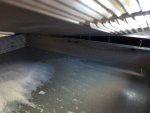Our pool build was in 2009. We've had the heater replaced twice already and today I noticed it leaking again. This one is 4 years old. Its the H250 electronic ignition. When the heater runs the leak seems to stop. I imagine when it cools the leak will return.
The history is the first was replaced under warranty. The second was out of warranty and I had to purchase a new one as they blamed my water chemistry. Since then, I have kept a log in my phone of every single water test I've done. I check every three days or so. Apart from the odd episode my numbers are where they should be.
Last night:
Cl-5.6
CC-0
Ph-7.8
TA-90
CYA-60
CH-390
Any ideas what is constantly eating my heat exchanger?
The history is the first was replaced under warranty. The second was out of warranty and I had to purchase a new one as they blamed my water chemistry. Since then, I have kept a log in my phone of every single water test I've done. I check every three days or so. Apart from the odd episode my numbers are where they should be.
Last night:
Cl-5.6
CC-0
Ph-7.8
TA-90
CYA-60
CH-390
Any ideas what is constantly eating my heat exchanger?


